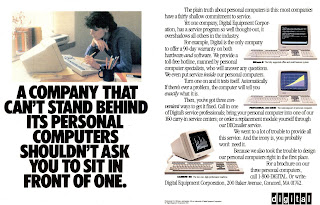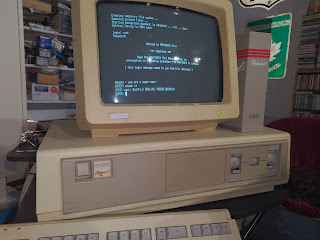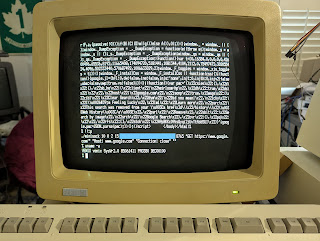In computing the DEC PDP-11 is something of a geologic feature. Plus, as most systems in the family were minicomputers, they had the whole monolith thing going for them too (minus murderous apes and sucking astronauts into hyperspace). Its fame is even more notable given that Digital Equipment Corporation was among the
last major computer companies to introduce a 16-bit mini architecture, beaten by the IBM 1130 (1965), HP 2116A (1966), TI-960 (1969) and Data General Nova (1969) — itself a renegade offshoot of the "PDP-X" project which DEC president Ken Olsen didn't support and even cancelled in 1968 — leaving DEC to bring up the rear with the PDP-11/20 in 1970.
So it shouldn't be a surprise that DEC, admittedly like many fellow mini makers, was similarly retrograde when it officially entered the personal computer market in 1982. At least on paper the DEC Rainbow was reasonable enough: CP/M was still a thing and MS-DOS was just newly a thing, so Digital put an 8088 and a Z80 inside so it could run both. On the other hand, the DECmate II, ostensibly part of the venerable PDP-8 family, was mostly treated as a word processor and office machine; its operating system was somewhat crippled and various bugs hampered compatibility with earlier software. You could put a Z80 or an 8086 in it and run CP/M and MS-DOS (more or less), but it wasn't a PC, and its practical utility as a micro-PDP didn't fully match the promise.

However, what DEC did to the PDP-11 was odder still. The 1982 DEC Professional 350 had the same F-11 ("Fonz") CPU as the bigger PDP-11/23, though that's where the similarity ends, as it implemented a new bus with completely different option cards and an incompatible interrupt system making it all but impossible to run unmodified PDP-11 programs. It had really nice graphics for 1982, but instead of the usual choices its intended system software was the laughably named Professional Operating System, or P/OS — execrated for its sluggish menus and limited feature set, of which people were only too quick to make the obvious joke. You could get CPU option cards like the DECmate II's to also make it into a weak PC or a weak CP/M machine, but they ran through P/OS too, and they weren't cheap. At the same time, however, in order to be the most inexpensive PDP-11 system ever, the low-binned DEC Professional 325 didn't even have a hard disk.
All of these systems were originally meant as commodity machines for office work, yet more or less with the exception of the Rainbow, they couldn't run much that office professionals actually wanted to run and little that existing PDP users did. Still, despite questionable technical choices, these machines (the Pros in particular) are some of the most well-built computers of the era. Indeed, they must have sold in some quantity to justify the Pro getting another shot as a high end system. Here's the apex of the line, the 1984 DEC Professional 380.

The Pro 380 upgraded to the beefier J-11 ("Jaws") CPU from the PDP-11/73, running two to three times faster than the 325 and 350. It had faster RAM and came with more of it, and boasted quicker graphics with double the vertical resolution built right into the logic board. The 380 still has its faults, notably being two-thirds the speed of the 11/73 and having no cache, plus all of the 325/350's incompatibilities. Taken on its merits, though, it's a tank of a machine, a reasonably powerful workstation, and the most practical PDP-adjacent thing you can actually slap on a (large) desk.
This particular unit is one of the few artifacts I have left from a massive DEC haul almost twelve years ago. It runs PRO/VENIX, the only official DEC Unix option for the Pros, but in its less common final release (we'll talk about versions of Venix). I don't trust the clanky ST-506 hard drive anymore, so today we'll convert it to solid state and double its base RAM to make it even more professional, and then play around in VENIX some for a taste of old-school classic Unix — after, of course, some history.



